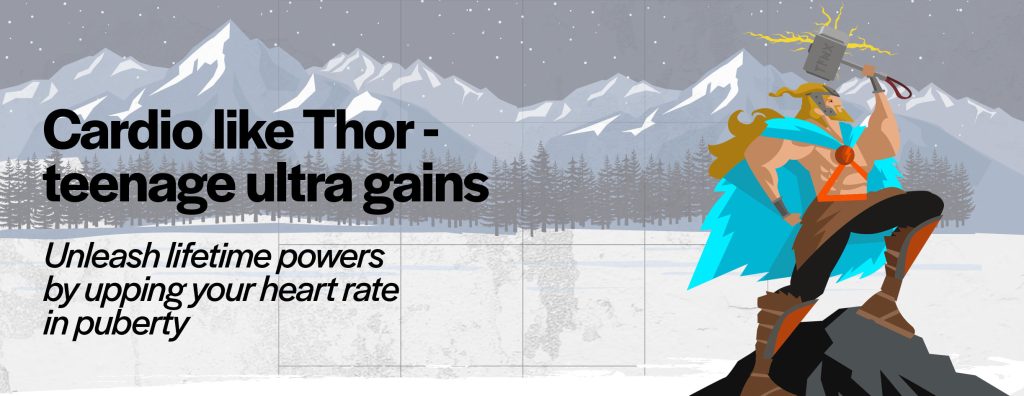The boom in youth development
As for bones and skeletal muscles, there is a time-window during your teens when the respiratory system grows at the fastest rate of your life.
Your heart, the muscle which controls your circulatory system, is closely linked to your respiratory system. Great news is, during puberty it starts responding to exercise. Your body is now capable of making your heart stronger, more efficient, pumping more blood (therefore oxygen) with less of the fatigue*****.
There’s better news still. In your early teens your lungs can now form extra capillary connections to maximise what’s called VO2Max, a key concept in fitness which I’ll explain below. Also blood vessels can become more elastic, which augments tolerance for exercise and recovery by a factor of 10. You’re parachuting into a world of fitness opportunity, so make the most of it!******.
Unlike strength, coordination and bone density, cardiovascular fitness can be achieved in later parts of your life as well, with good results. But still, during puberty, you’ve got four aces in your hands – don’t fold when it’s actually time to go all in!*
Fueled by oxygen
Air is a mix of gases containing oxygen (O2) and carbon dioxide (CO2). We instinctively recognize the former as good for us and the latter as the “bad gas”.
The “oxidative” system (from the word oxygen) is your default source of energy. When you’re walking, sitting, sleeping or cleaning your room, oxygen gives you the energy.
Your respiratory muscles make your ribcage expand and air flows in. You might recognise this table from school – you can see that a lot of the oxygen – valuable as it is – is simply exhaled out – underutilised!
| Gas | % in inhaled air | % in exhaled air |
| Oxygen | 21 | 16 |
| Carbon dioxide | 0.5 | 5 |
| Nitrogen | 78 | 78 |
This is an average, since during strenuous exercise a little more oxygen is absorbed, and when resting, a little less***.
The inside of the lungs is lined with a myriad of tiny bubbles, called alveoli, which in turn are filled with capillaries. Capillaries bring the “dirty” blood full of carbon dioxide, release it and replace it with freshly inhaled oxygen, ready to go everywhere in your body and bring energy to each single cell!
Millions of powerhouses
Once your fresh, bright red oxygenated blood reaches the cell, a small powerhouse called a mitochondrion gets to work. Glucose and oxygen are combined, creating an explosive mix that releases water, carbon dioxide and a huge amount of energy, capable of sustaining the cell in all its functions.
Sure, your body has other ways of producing energy, but these amazing mitochondria generate around 95% of your whole daily production (close to 100% if you don’t do any strength sport)***.
Let’s zoom in on muscle cells. Some of them are super specialised in the use of oxygen: the type I muscle fibres are also known as “red fibres”[hyperlink] as they are packed with capillaries to maximise blood flow. Plus, some of them have more than one mitochondrion – supercharged!
VO2Max
It’s actually tricky to establish exactly how capable your respiratory system is of sustaining prolonged aerobic exercise. Imagine you decide to race 5km on a track to prove who has got the best lungs, and I win. Then we cycle for 30km, and this time you win. Why? The result could be influenced by many factors (running/cycling technique, specific neuromuscular adaptations, leg strength, flexibility, latent injuries, etc.), factors that are perfectly normal and make you and your abilities unique, but don’t give us an absolute value of how efficient your lungs are in exchanging gas.*
There is only one way to find out exactly, and that’s in a sports science lab. The Volume of O2 Maximum (VO2Max) exchanged with its CO2 counterpart is monitored by wearing a mask with sensors, so the computers can detect the exact percentages. [personal note? Something on how this info can be used?]
References
* Lloyd, S. R, Oliver, L. J. (2014) Strength and Conditioning for young athletes: science and applications. London: Routledge.
**NASA (2021) ‘Interesting things about climate’ [online] Available from: https://climate.nasa.gov/news/2491/10-interesting-things-about-air/#:~:text=Air%20is%20mostly%20gas&text=The%20air%20in%20Earth%27s%20atmosphere,dioxide%2C%20neon%2C%20and%20hydrogen. [18/05/21]
***Ratamess, N. (2012) ACSM’s Foundations of Strength Training and Conditioning. Philadelphia: Lppincott Williams and Wilkins.
*****Mahmoud O., Granell R., Tilling K., Minelli C., Garcia-Aymerich J., Holloway J. W., Custovic A., Jarvis D., Sterne J., Henderson J. (2018) ‘Association of Height growth in puberty with lung function’. American Journal of Respiratory Critical care Medicine, 192(12), 1539-1548.
******Koechlin C., Matecki S., Jaber S., Soulier N., Prefaut C., Ramonatxo M. (2005) ‘ Changes in Respiratory Muscle Endurance during Puberty’. Journal of Pediatric Pulmunology, 40, 197-204.
Further reading
Nève V., Girard F., Flahaul A., Boulè M., (2002) ‘Lung and thorax development during adolescence: relationship with pubertal status’. European respiratory Journal, 20, 1292-1298.





